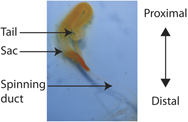Article contents
With great structure comes great functionality: Understanding and emulating spider silk
Published online by Cambridge University Press: 18 December 2014
Abstract

The overarching aim of biomimetic approaches to materials synthesis is to mimic simultaneously the structure and function of a natural material, in such a way that these functional properties can be systematically tailored and optimized. In the case of synthetic spider silk fibers, to date functionalities have largely focused on mechanical properties. A rapidly expanding body of literature documents this work, building on the emerging knowledge of structure–function relationships in native spider silks, and the spinning processes used to create them. Here, we describe some of the benchmark achievements reported until now, with a focus on the last five years. Progress in protein synthesis, notably the expression on full-size spidroins, has driven substantial improvements in synthetic spider silk performance. Spinning technology, however, lags behind and is a major limiting factor in biomimetic production. We also discuss applications for synthetic silk that primarily capitalize on its nonmechanical attributes, and that exploit the remarkable range of structures that can be formed from a synthetic silk feedstock.
Information
- Type
- Articles
- Information
- Journal of Materials Research , Volume 30 , Issue 1: Focus Issue: Soft Nanomaterials , 14 January 2015 , pp. 108 - 120
- Copyright
- Copyright © Materials Research Society 2015
References
REFERENCES
- 12
- Cited by

